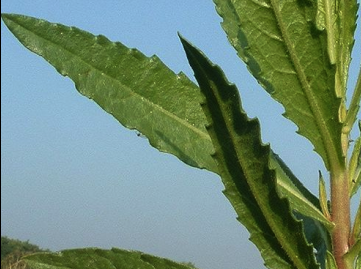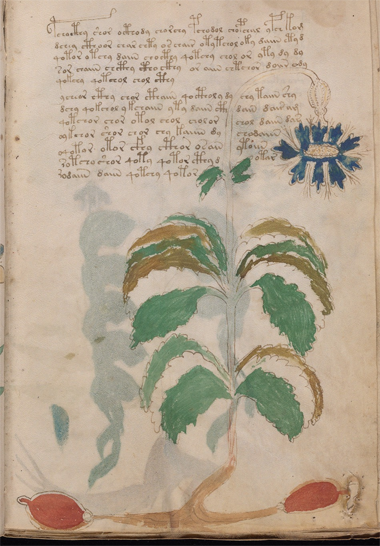 A quick glance at VMS Plant 10r reminded me of a daisy (family Asteraceae). It has serrated leaves and the characteristic flower whorl that is common for plants in the daisy family. The illustrator has also taken some pains to emphasize the serrated leaves, which gave me some ideas for the identity of the plant… I thought one possibility might be Senecio alpinus (Alpine ragwort) but… many daisies look the same, and the color of flower petals doesn’t help because the VMS is painted with a limited palette and some of the colors might be symbolic.
A quick glance at VMS Plant 10r reminded me of a daisy (family Asteraceae). It has serrated leaves and the characteristic flower whorl that is common for plants in the daisy family. The illustrator has also taken some pains to emphasize the serrated leaves, which gave me some ideas for the identity of the plant… I thought one possibility might be Senecio alpinus (Alpine ragwort) but… many daisies look the same, and the color of flower petals doesn’t help because the VMS is painted with a limited palette and some of the colors might be symbolic.
More importantly, daisies don’t have big red roots that look like yams or water balloons. For a while, I was at a loss to explain the roots.
Prior Plant IDs
I had a suspicion VMS 10r might be Dittrichia viscosa, a plant common to the Mediterranean that has medicinal uses as an astringent, and a strong fragrance (that not everyone finds agreeable). But, I don’t think the red objects are meant to be noses, so what else could they be?
I hadn’t previously looked up other IDs for this plant. I wasn’t even sure what Sherwood had chosen, so I looked around while I was composing this blog and found Sherwood’s ID of Cichorium pumilum. I’m very familiar with chicory, it grows wild in this area, and 10r doesn’t look like chicory, so I searched again…
This time I found Ellie Velinska’s description of the plant as mountain cornflower (Centaurea montana). Except for the discrepancy in the leaves, I like this ID, because it more closely matches the characteristics of the plant and Velinska gives a plausible explanation for the roots as a mnemonic for an ocular medicinal use but, I think there might be another possibility…
I didn’t want to spend a lot of time googling plant IDs, so I stopped looking so I could talk about Dittrichia viscosa, also known as false yellow fleabane. It is also called “aromatic inula” for its strong fragrance and resemblance to Helenium (Inula).
I’ve said many times that I believe the VMS illustrator cared about leaf margins and drew them quite accurately for some of the more naturalistic plants. This is unusual compared to traditional herbals where leaf margins are often sloppy or wildly inaccurate. Dittrichia viscosa has very distinctive leaves that are deeply serrated and the VMS seems to convey this.
D. viscosa flowers are typical for plants in the daisy family, a sunny ray of yellow petals and a rayed whorl after the seed-fluff has blown away. This plant is well-known around the Mediterranean, from Provençe, Spain, and Sicily to the Levant, and has long been the subject of folklore. For example, Wiki notes a Catalan saying, “Els raïms són madurs quan floreixen les olivardes.”, the grapes are ripe when the yellow [false] fleabane blooms. Unfortunately, the roots don’t look like grapes, at least not entirely.
Is there another way to explain the roots? I couldn’t think of a reason why Senecio alpinus would be drawn with red water-balloon roots. And if it’s Dittrichia viscosa and they’re not grapes (or eyeballs as Velinska suggested), what else could they be?
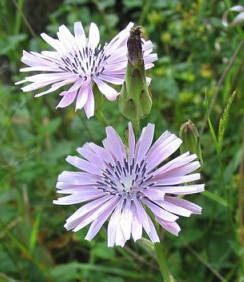 [Addendum: One idea I forgot to include when I posted this blog earlier today is that the big red “balloons” might be breasts—lactating glands. Lactuca plants are widespread Eurasian plants named for the milky white sap that oozes from the stems when you break them and Lactuca is part of the daisy family. However, as tempting as this idea is, I wanted to suggest one further possibility…]
[Addendum: One idea I forgot to include when I posted this blog earlier today is that the big red “balloons” might be breasts—lactating glands. Lactuca plants are widespread Eurasian plants named for the milky white sap that oozes from the stems when you break them and Lactuca is part of the daisy family. However, as tempting as this idea is, I wanted to suggest one further possibility…]
Farther Afield
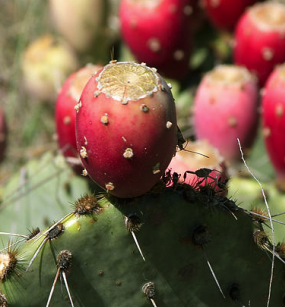 If the VMS were created after the conquest of the Americas, the roots might represent red potatoes, oca (Oxalis), or prickly pears (Opuntia), those mouse-ear-shaped lumps that form on the top of cactus plants. The Nahuatl called them Nopalli, and while their origin is not completely clear, they are thought to have originated in Mexico. Prickly pears are now grown worldwide, and D. viscosa is used like a duster to clean off the pear-like fruit after it is harvested.
If the VMS were created after the conquest of the Americas, the roots might represent red potatoes, oca (Oxalis), or prickly pears (Opuntia), those mouse-ear-shaped lumps that form on the top of cactus plants. The Nahuatl called them Nopalli, and while their origin is not completely clear, they are thought to have originated in Mexico. Prickly pears are now grown worldwide, and D. viscosa is used like a duster to clean off the pear-like fruit after it is harvested.
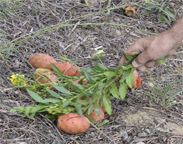
Using false fleabane to clean prickly pears, courtesy of Carmelo Rifici.
But the New World theory is problematic. The VMS probably predates Columbus’s voyage to the Americas. Is it possible that the practice of cleaning prickly-pear fruit with daisy dusters comes from a long-standing Mediterranean tradition of cleaning similar-looking crops native to the Old World?
What about red-skinned shallots, which are smooth and fairly oval and have a little bump on the ends? Or radishes or beets? All of these come from the ground and need the dirt dusted off, and even radishes, which originated in Asia, have been grown in Europe since before Roman times. The toothy leaves of false fleabane are well suited for dusting. If the VMS roots are meant to express a characteristic of the plant, maybe the roots are breasts. On the other hand, if they show the use of the plant, maybe Velinska is right, maybe they are eyeballs, or maybe they are tubers that need a daisy-leaf dust-off before dropping them in the cart for market.
J.K. Petersen
© Copyright 2017 J.K. Petersen, All Rights Reserved

